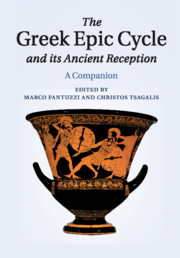Book contents
- Frontmatter
- Contents
- List of illustrations
- List of contributors
- Editorial note
- Introduction: Kyklos, the Epic Cycle and Cyclic poetry
- PART I APPROACHES TO THE EPIC CYCLE
- PART II EPICS
- PART III THE FORTUNE OF THE EPIC CYCLE IN THE ANCIENT WORLD
- 22 The aesthetics of sequentiality and its discontents
- 23 The Epic Cycle, Stesichorus, and Ibycus
- 24 Pindar's Cycle
- 25 Tragedy and the Epic Cycle
- 26 The Hellenistic reception of the Epic Cycle
- 27 Running rings round Troy: Recycling the ‘Epic Circle’ in Hellenistic and Roman art
- 28 Virgil and the Epic Cycle
- 29 Ovid and the Epic Cycle
- 30 Statius' Achilleid and the Cypria
- 31 The Epic Cycle and the ancient novel
- 32 The Epic Cycle and imperial Greek epic
- Works cited
- Index of principal passages
- Index nominum et rerum
22 - The aesthetics of sequentiality and its discontents
from PART III - THE FORTUNE OF THE EPIC CYCLE IN THE ANCIENT WORLD
Published online by Cambridge University Press: 05 August 2015
- Frontmatter
- Contents
- List of illustrations
- List of contributors
- Editorial note
- Introduction: Kyklos, the Epic Cycle and Cyclic poetry
- PART I APPROACHES TO THE EPIC CYCLE
- PART II EPICS
- PART III THE FORTUNE OF THE EPIC CYCLE IN THE ANCIENT WORLD
- 22 The aesthetics of sequentiality and its discontents
- 23 The Epic Cycle, Stesichorus, and Ibycus
- 24 Pindar's Cycle
- 25 Tragedy and the Epic Cycle
- 26 The Hellenistic reception of the Epic Cycle
- 27 Running rings round Troy: Recycling the ‘Epic Circle’ in Hellenistic and Roman art
- 28 Virgil and the Epic Cycle
- 29 Ovid and the Epic Cycle
- 30 Statius' Achilleid and the Cypria
- 31 The Epic Cycle and the ancient novel
- 32 The Epic Cycle and imperial Greek epic
- Works cited
- Index of principal passages
- Index nominum et rerum
Summary
The aesthetics of the Iliad and Odyssey represented something most probably unusual in the archaic age, with their detailed narrative pace, their selection of chronologically limited and unified time-spans, and their frequent deviations from the chronological order of events. In contrast to (what we now label) the ‘Homeric’ poems, the narrative strategies of the other poems in the Epic Cycle may have been the norm – strategies well suited to an audience's horizon of expectations at the time when the poems were first performed. In the pages that follow, I will try to investigate when and why the Epic Cycle could no longer satisfy the aesthetic expectations of both later readers and post-archaic literary critics. As we shall see, the Epic Cyclic poems turned into a practical (and indispensable) reference for Theban and Trojan mythology, and yet they seem to have been less and less read; above all, they came to function as a poetic foil against which the different mechanics of Homeric narrative were defined. Of course, the fact that the poems were condensed into epitomizing summaries – transformed into easy-to-swallow pills that were widely consulted from the Hellenistic age onwards – does not by itself prove that the ‘originals’ were no longer read. But the phenomenon does demonstrate that – differently from the summaries – the original poetic form of the Cyclic poems ended up being seen as dispensable, at least for many post-classical readers.
Before Aristotle
If we are ready to believe that vase-painters drew their inspiration not only from oral and more or less non-canonical versions of the Trojan-War myths, but also from canonical poems such as the Iliad, the Odyssey, and the Cycle they heard performed in public, then ‘we should have to assume that Arctinus of Miletus, who wrote the Aethiopis, and Stasinus, author of the Cypria, were far more beloved than Homer’. The impression that the Homeric poems did not receive any privileged attention in the archaic age as models for the iconographical imagination, and that the Cyclic texts were at least as dominant as Homer, has been amply confirmed in the last decades.
- Type
- Chapter
- Information
- The Greek Epic Cycle and its Ancient ReceptionA Companion, pp. 405 - 429Publisher: Cambridge University PressPrint publication year: 2015
- 5
- Cited by



